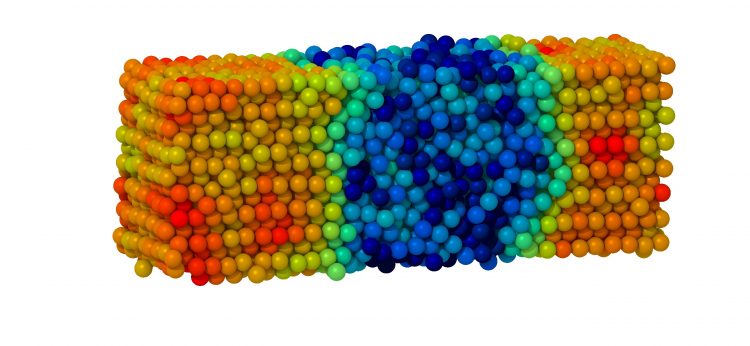Improved computer simulations enable better calculation of interfacial tension

At coexistence, the crystal (red) and the fluid (blue) are separated by interfaces. The simulation box shown here contains 3,660 hard sphere particles. Using periodic boundary conditions and finite-size scaling (systematic variation of the box size), computer simulations allow high precision measurements of the interfacial tension. source: Fabian Schmitz, Institute of Physics, JGU
Computer simulations play an increasingly important role in the description and development of new materials. Yet, despite major advances in computer technology, the simulations in statistical physics are typically restricted to systems of up to a few 100,000 particles, which is many times smaller than the actual material quantities used in typical experiments.
Researchers therefore use so-called finite-size corrections in order to adjust the results obtained for comparatively small simulation systems to the macroscopic scale. A team of researchers from Johannes Gutenberg University Mainz (JGU) has now succeeded in better understanding how this technique works when it is used to assess interfacial tension, thus enabling more accurate predictions.
The interfacial tension is an important physical quantity of many phenomena, such as the nucleation of water droplets in the atmosphere, the crystallization of proteins from solutions, and the growth and stability of nanocrystals. It occurs at the interface between different phases of a material, i.e., on the transition between solid, liquid, and gaseous phases.
However, the interfacial tension is difficult to measure experimentally, and reliable analytical theories about it are also lacking. Thus it is of particular importance to develop computer simulation techniques for this phenomenon.
Using an innovative simulation method, Fabian Schmitz, Dr. Peter Virnau, and Professor Kurt Binder of the Condensed Matter Theory group at JGU's Institute of Physics have now succeeded in gaining a better understanding of the nature of finite-size corrections in the determination of interfacial tension.
This work, achieved only after several million CPU hours on the Mainz supercomputer MOGON, will in the future help researchers to analyze interfacial tension with the highest precision by means of simulations. The results were published in the leading journal Physical Review Letters.
High-performance computing becomes increasingly important at Johannes Gutenberg University Mainz. The planned new supercomputer MOGON II is expected to replace the current system in the first quarter of 2016. It is expected that MOGON II will be among the top 100 fastest high-performance computers worldwide.
Publication:
Fabian Schmitz, Peter Virnau, Kurt Binder
Determination of the Origin and Magnitude of Logarithmic Finite-Size Effects on Interfacial Tension: Role of Interfacial Fluctuations and Domain Breathing
Physical Review Letters, 26 March 2014
DOI: 10.1103/PhysRevLett.112.125701
Further information:
Dipl.-Phys. Fabian Schmitz
Condensed Matter Theory
Institute of Physics
Johannes Gutenberg University Mainz (JGU)
D 55099 Mainz, GERMANY
phone +49 6131 39-24104
fax +49 6131 39-25441
e-mail: schmifa@uni-mainz.de
http://www.komet331.physik.uni-mainz.de/schmitz.php
http://www.uni-mainz.de/presse/17291_ENG_HTML.php – press release ;
http://journals.aps.org/prl/abstract/10.1103/PhysRevLett.112.125701 – article ;
http://www.uni-mainz.de/presse/17279_ENG_HTML.php – press release “EUR 8.7 million for new MOGON II high-performance computer at Johannes Gutenberg University Mainz”
Media Contact
More Information:
http://www.uni-mainz.deAll latest news from the category: Information Technology
Here you can find a summary of innovations in the fields of information and data processing and up-to-date developments on IT equipment and hardware.
This area covers topics such as IT services, IT architectures, IT management and telecommunications.
Newest articles

Properties of new materials for microchips
… can now be measured well. Reseachers of Delft University of Technology demonstrated measuring performance properties of ultrathin silicon membranes. Making ever smaller and more powerful chips requires new ultrathin…

Floating solar’s potential
… to support sustainable development by addressing climate, water, and energy goals holistically. A new study published this week in Nature Energy raises the potential for floating solar photovoltaics (FPV)…

Skyrmions move at record speeds
… a step towards the computing of the future. An international research team led by scientists from the CNRS1 has discovered that the magnetic nanobubbles2 known as skyrmions can be…





















